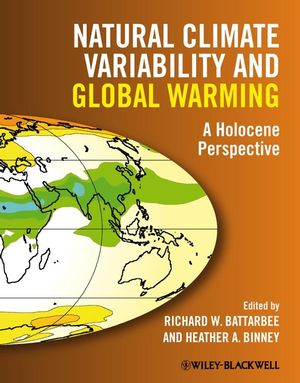Natural Climate Variability and Global Warming: A Holocene PerspectiveISBN: 978-1-4051-5905-0
Hardcover
288 pages
August 2008, Wiley-Blackwell
 |
||||||
"Volumes such as this provide the historical contexts and broad overviews needed to advance climate change biology toward broader conceptual developments and synthetic methodologies for understanding and predicting climate change effects, as well as developing effective adaptation and mitigation strategies.". (The Quarterly Review of Biology, 1 December 2010)
“This is an important book for understanding climate changes in a longer perspective.” (Geologos, 2010)
“This book brings together some of the most prolific names in their field to create a sound and interesting look into this area.” (The Environmentalist, November 2009)
“It highlights the need to improve not only our understanding of the physical system through time but also our knowledge of human influence on the climate system and vice versa.” (Bulletin of the American Meteorological Society , April 2009)
“Although aimed at ‘researchers and advanced students’, this layman found the book perfectly accessible.” (Geoscientist, August 2009)
"The rapid climate change that seems to be occurring world-wide make this volume both timely and instructive, concentrating as it does on the Holocene period.... An essential addition for an meteorological library." (The International Journal of Meteorology, April 2009)
The Holocene, the interval covered by the last 12,000 years, represents a largely nonglacial period in Earth's climatic evolution. This book synthesizes the climate history of this interval and investigates the role of natural climate variability in explaining current global warming. The volume contains ten chapters written by experts in various aspects of past climate change. Chapter 1 provides a short introduction and outlines the objectives/contents of subsequent chapters. The next chapter, the longest (51 pages), considers the progress, paradigms, and problems in Holocene climate research. Chapter 3 addresses the fundamental question of the human role in the changing climate of the Holocene while acknowledging that climate change itself has strongly impacted the history of civilizations. Our ability to predict future climate depends on our ability to reconstruct and model what has already happened; chapter 4 explores this vital issue. Subsequent chapters examine some relevant intervals including the so-called Holocene thermal optimum, and evaluate and model what natural processes might have contributed to observed climate histories. The final chapters assess rapid land-cover change and analyze future climate change within the perspective of the last 12,000 years. Includes chapter references, an eight-page index, and a three-page summary of abbreviations and dating conventions. Summing Up: Recommended. Graduate students, researchers, faculty, professional audiences. -- J. T. Andrews, University of Colorado at Boulder (Choice, February 2009)



